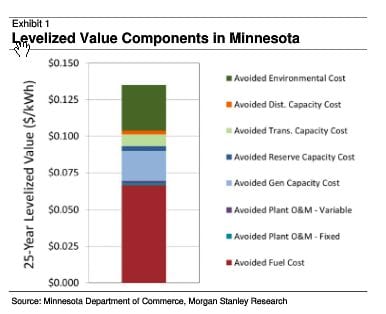Households in Australia adding solar PV arrays to their rooftops have an important question to ask themselves: Are they getting a fair deal from their local utility for the solar power that they export back to the grid?
Why is it, they might wonder, that households in regional Queensland which pay 26c/kWh (even after state-sponsored subsidies) for their electricity from the grid will get just 6.321c/kWh for their solar exports? In some areas, such as south-east Queensland or NSW, there is no obligation to pay households at all.
Yet in Minnesota, a state in the US (think of the film Fargo), households which pay a retail electricity rate of just 12c/kWh are being offered 10.9c/kWh for the solar that they export back to the grid.
It all comes down to they way the solar is valued. In Australia, the amount paid for solar power exported to the grid by households and businesses is mostly framed around the value to the electricity retailers – not to consumers in general, or the overall grid.
Hence, in the deliberations by the state regulator the Queensland Competition Authority, it is only concerned with what it claims are the “avoidable” costs of delivery. This only includes the cost of wholesale generation, transmission losses, and some minor ancillary services.
Here are its calculations.
But consider what Minnesota calculated – illustrated in the graph below. Not only did it take into account the avoided fuel cost, but various transmission and distribution capacity costs, avoided generation capacity costs and, most tellingly, the avoided environmental cost.
(It should be noted here that the total adds up to 13.5c/Wh, which is the Minnesota commission’s estimate of the levellised cost over the lifetime of the asset.)
This has something to do with the different structures of electricity bills in the two different regions, but mostly it is about how the pricing regulators in Australia, and Queensland in particular, see their mandate.
As we remarked last year, the QCA sees its role as protecting the interests of business. When it was deliberating a special tariff on solar households, it came to the conclusion that it was unfair, ineffective, more expensive, and possibly illegal, but it recommended the course of action, anyway, because it would benefit the network operators.
Part of the problem in Australian states such as Queensland is that the ultimate arbiter of pricing is the state government – the very same entity that owns the network and generation businesses threatened by solar and distributed generation, and the same entity that appoints the regulator. It is a clear conflict of interest.
Compare the QCA findings with what others have suggested. The Australian Photovoltaic Institute, for instance, suggests that the tariff for exports should include avoided transmission costs, and the hefty retail margins and “head-room” components of the bill.
And there is a strong case for the household to benefit from the “merit order effect” – the downward pressure on wholesale prices caused by renewables – as well as some of the network benefits created by avoided infrastructure investment. Right now, all these benefits are being captured by the incumbent utilities.
The other point the APVA makes is that in regional Queensland, the real costs of delivery from grid-power are not reflected in the household bill because of the state government subsidy – which amounts to $600 million a year. Perhaps the tariff paid to solar households should reflect the real avoided costs, not just the subsidised avoided costs.
“Costs incurred merely to maintain an existing system, which may not be the most efficient or suitable in the longer term, would not be considered justifiable,” it wrote in a submission last year.
As Nigel Morris suggested in his piece on Tuesday, retailers are clearly making a profit selling the solar generated electricity from one household (which they buy for 6c/kWh, or 8c/kWh, or sometimes nothing at all) to the next-door neighbour at the full retail price – sometimes hugely inflated if they are on time-of-use tariffs. Morris puts that profit at around $10 million. I reckon that is barely scratching the surface.
In NSW, it will be interesting to see what happens when the households which signed up to the 60c/kWh gross feed-in tariff find their contracts ending in 2016. Right now, they have no real incentive to change their usage patterns, but when that tariff ends, there will be a huge incentive to consume more of that output on site – and quite possible to invest in the battery technology that can do that at a reasonable price.
This was one of the key points underlined in the Morgan Stanley analysis we wrote about on Tuesday. The more utilities respond by refusing connections, hiking fixed tariffs, and paying sub-value rates for exports, the more incentive there is for households and business customers to disconnect entirely from the grid.
There is no customer that has been so enamoured of their relationship with their utility that they would feel bad about breaking the link. RenewEconomy has been struck by the number of different proposals – and economic incentives – there are to take individuals and communities off-grid. Sooner, rather than later, that will happen, and the utilities will have no one but themselves to blame.












